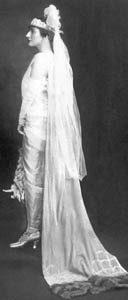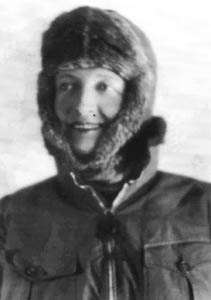![[Metroactive Arts]](/gifs/art468.gif)
[ Arts Index | North Bay | Metroactive Home | Archives ]
Heiress and adventurer Louise Boyd's dual existence
By Jordan E. Rosenfeld
You can have your famous women of history: gun-slinging Western gals, frontierswomen and female pilots. Give me Louise Boyd any day. A Marin County heiress to a gold-rush fortune and a groundbreaking arctic adventurer, Boyd resisted socially dictated constraints, taking up a pastime that put the female hobbies of her peers--like lace tatting and croquet--to shame.
Her critics, and even some admirers, felt the socialite-turned-explorer led a split life unbefitting her gender and station in Depression-era society. After visiting with curator Dawn Laurant of the Marin History Museum--which is hosting an exhibit on Boyd subtitled "Marin's Arctic Explorer" showing through August--and perusing Boyd's possessions, I feel confident that Boyd would have proclaimed that hers was not a split life, but rather a complete one. She found ways to satisfy both her debutante self (this woman knew how to throw good parties) as well as her free, ruffian self, who rode horses with her brothers during childhood summers.
Born in 1887 and described as "tall, poised and blue-eyed" (read: not beautiful), Boyd had the finishing-school degree and comportment of a lady and future wife, though not a single prospective husband appeared in the picture. But if her beauty was in question, her decisiveness was not. When the arctic ambrosia took possession of her on a tourist cruise of Norway at age 34, she put aside her fine china, heirloom jewelry and her father's investment company to sail glacier-laden waters seven more times.
Boyd's possessions, made possible by the estimated $35 million fortune she derived from her father and uncles' 19th-century California gold strike, reveal the rival aspects of her nature. A pair of mother-of-pearl and gold-inlaid opera glasses sit opposite her rugged, black expedition binoculars. A silver, engraved picnic set, which looks too dainty and pristine to have ever left the house, rests against a battered, plain leather traveling case. Two weathered snow shoes tower over an ivory pocket knife, embossed leather journals and a beautiful silver compass.
Double Life: Marin heiress Louise Boyd seen dressed for presentation at court...
The photographs at the museum also show Boyd's dual aspects. In one photo, she reclines like a heroine from an F. Scott Fitzgerald novel draped in elegant silk and beads, her Roman nose and smug grin framed by feline eyes tilted slightly down. In another, only a portion of her face, a giddy smile, is visible within the thick, fur-lined expedition gear. She looks like a woman who could barely be bothered to sit still for the camera and who eventually would prefer to be behind it.
It must be asked why Boyd, who grew up swaddled in privilege, chose to finance and spearhead dangerous arctic expeditions, primarily of Greenland, Denmark and Norway, from which people often did not come back alive and on which she had her share of close calls. Laurant believes Boyd was drawn to the arctic as a "final frontier" beyond all the continents she had already traveled.
"She wrote that the arctic held a beauty she wanted to unlock. Once she got inside the landscape, she would never be outside of it again," Laurant says. "Her first impression of the arctic was of a blank and soundless world, but that she soon came to know the tremendous variation inside it, and it opened up some of its mystery to her."
Indeed, a passage from one of Boyd's journals delivers a mortal meditation on the arctic, a lyric piece of PR: "The icebergs in the fiords--so majestic in height and size--give one a first impression of permanence and everlasting durability. This idea is soon dispelled, however, a booming sound and an instant later what had seemed indestructible is an unrecognizable mass of broken ice."
For a woman whose considerable wealth came to her as the result of so many deaths of those beloved to her--her two younger brothers, her parents and her uncles--one could easily believe that "inside" the arctic, with its reputation for the barren, Boyd sought a tangible mirror of the death that felled her family. And in her explorations, it appears she found these icy climes to be full of life, compelling her to return.
Alternately, perhaps Boyd wanted an antidote to privileged boredom, to go far from the strictures of civilized high society that was a part of her life on land. It's hard not to imagine that the mansion known as Maple Lawn, which belonged to her parents, and the Gate House built by her grandfather, which became a temple to her deceased brothers, were suffocating tributes to loss. Donated to Marin County in honor of her brothers in 1935, the Gate House has been the home of the Marin History Museum since the mid-'60s.
It's also easy to cultivate an image of Boyd as a lost and lonely spinster, or perhaps a closeted lesbian, since, as Laurant notes, no amount of digging through her letters and journals reveals a hint of a lover. But it is clear that Boyd did have one great love: the chilled beauty of the arctic itself, the thrill of discovery to which her wealth allowed her access.
With no experience, in 1926 she chartered a Norwegian sealing vessel, the MS Hobby, and hired a team of polar experts and scientists for a further expedition of the icy wastes of the arctic. Stakes were high and skeptics were full of wind that the heiress could not do anything that male explorers before her, like Antarctic explorer Sir Ernest Shackleton, hadn't already done. Not one to halt for criticism, Boyd handled everything herself, from hiring crew to ordering provisions (the lists read like ingredients for a feast) and equipment (these crews were likely the envy of others), financing the venture in full.
On that first trip, Boyd even did some hunting, bagging a few polar bears, next to one of which she is proudly posed in a photo. According to Laurant, she soon realized this wasn't an appropriate way to treat the wildlife she so admired. On the next of her seven total expeditions, all shots fired were from her Kodak Eastman.
This particular camera had its standard wood construction replaced with aluminum to make it arctic-friendly. Louise later sold this camera to her friend Ansel Adams, who went on to use it for years. Her photographs became well-known and won her the prestigious Cullum Geographical Medal from the National Geographic Society, which also published two of her books.
Both by chance and by intention, many of Boyd's trips did serve larger purposes. In 1928 she garnered international attention when she joined a search in Greenland for the missing explorer Roald Amundsen. Boyd changed her personal plans and led a 10,000-mile search for Amundsen, traversing the coast of Spitzbergen and crisscrossing the Greenland Sea.
Though the lost explorer was never found, King Haakon of Norway recognized Boyd's contribution and presented her with the Chevalier Cross of the Order of St. Olav. She was the first woman to ever receive this honor. It wouldn't be her last medal; Boyd was eventually as decorated as a war veteran, earning five other honors, among them medals from the Swedish and French governments.
Boyd's gritty determination took her to places no one had ever been. During a 1931 expedition, she made it to Ice Fjord, an inlet never before visited by ship. The Danish government named the area Weisboydlund, or "Miss Boyd Land," in her honor. Who needs a husband when they're naming fjords after you?
Still, it's clear that her biggest contributions were her photographs--bigger even than her assignment for the U.S. government leading reconnaissance to provide maps, charts and photographs essential to radio transmissions between allied pilots and submarines during WWII. Only a fraction of her photos hang on the Marin History Museum's walls. Most are retained in the National Geographic collections, but even the handful here are enchanting.
Boyd's photographs of glaciers and fjords are shocking and gorgeous. Life throbs inside contrasting configurations of dark water and bright icebergs. It's hard not to fall prey to the obsession that bit Boyd, imagining oneself trekking blank slates of ice, and navigating through subzero temperatures and bone-carving winds.
Boyd's final expedition, in 1955 when she was 68, was not by sea. During all her trips, she had had never come closer than 300 miles to the North Pole. She chartered a DC4 plane and crew and made headlines again by becoming the first woman to fly over the North Pole, as well as the first person to privately finance such a journey. After that, she retired back to the civilized world of parties and connections, though she maintained correspondence with many of her expedition associates, who had come to respect, admire and possibly even fear the regal woman who out-hiked and out-endured them yet stood to lose a lot more than they.
Eventually having to depend on friends for subsistence, Louise Boyd died on the eve of her 85th birthday, her fortune spent but surely not, as some have suggested, squandered.
[ North Bay | Metroactive Central | Archives ]
Copyright © Metro Publishing Inc. Maintained by Boulevards New Media.
![]()
Ice Queen

Photographs courtesy of Marin History Museum

...and an arctic expedition.
'Louise Boyd: Marin's Arctic Explorer' exhibits through August at the Marin History Museum, 1125 B St., San Rafael. Hours are Monday and Wednesday-Thursday, 1pm-3pm, and the third Saturday of each month, noon-4pm. Free. 415.454.8538.
From the February 25-March 3, 2004 issue of the North Bay Bohemian.